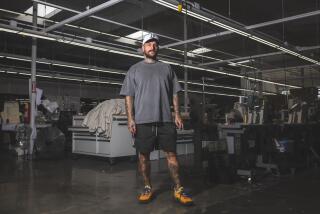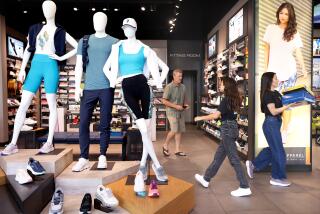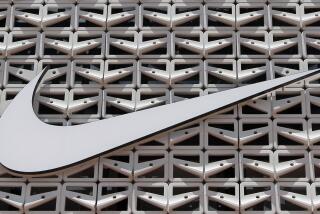Nike, Foot Locker Going Toe-to-Toe Over Sneakers
Nike Inc. knows who’s been naughty and nice. So now that it’s nearly Christmas, is it time for a little retail revenge?
Some say that’s exactly what the athletic shoe behemoth has in mind for its biggest customer, Foot Locker Inc.
Although Nike will be releasing limited editions of Air Jordan models to Foot Locker’s rivals during the holiday shopping season, it won’t be sending a single pair to the New York-based retail chain.
A Nike spokeswoman said the move is strictly business, driven by shifting alliances within a competitive industry and Foot Locker’s desire to stock less-expensive items.
But analysts and insiders say Nike’s decision to snub the nation’s largest sneaker outlet is nothing less than payback -- the latest twist in a corporate slap fest between two of the biggest names in the $16.3-billion athletic footwear industry.
“Nike’s trying to discipline them,” said Theresa Meyer, an analyst for investment firm D.A. Davidson & Co. “This has kind of shaken up the sneaker world a little bit.”
Call it the battle of the Big Foots.
With $5.5 billion in footwear sales alone, Nike is the undisputed king of athletic shoe makers, with revenue more than twice that of rival Adidas. Nike is known for marquee brands that are high priced, marketed with celebrity sizzle and feature cutting-edge technology.
Meanwhile, Foot Locker rules retail. It racked up $4.4 billion in 2001 sales via its nearly 3,600 worldwide outlets, most of them in suburban malls.
The two companies have been in lock-step as the athletic shoe market has ballooned. Foot Locker is Nike’s biggest customer, buying 11% of its output. Nike is Foot Locker’s biggest supplier, accounting for nearly half of the shoes on its shelves.
The star of Nike’s lineup is the Air Jordan, named after basketball superstar Michael Jordan. During a recent “retro” launch of a classic Jordan shoe, there were near-riots at malls in Sacramento and Ohio. Teenagers willing to wait for hours to be among the first to buy Nike’s newest Air Jordan model could depend on finding it at a Foot Locker.
Not anymore.
The tale of the latest Jordan releases tracks a relationship that has become increasingly strained over clashing visions of the sports shoe market, according to analysts, executives’ remarks and Securities and Exchange Commission disclosures.
Things started to chill earlier this year, after Nike released its latest model, the Air Jordan XVII. Packaged in a silver metallic, velvet-lined briefcase with a “making of the shoe” CD, the basketball sneakers cost an unprecedented $200 a pair. Fifty percent were sold within four days, an impressive rate but relatively sluggish for Jordans, which typically hit that figure in the first two days. The industry standard is 15% sell-through in the first two days, according to a Nike spokeswoman.
Despite the initial flurry of purchases, analysts say Foot Locker struggled with the Jordan XVII line as well as Nike’s $160 Shox, Vince Carter’s signature model.
Foot Locker executives declined to comment this week, but the company’s 2002 first-quarter report blamed a 5.5% drop in operating profit on “markdowns taken to sell slow-moving marquee product.”
Citing tighter consumer purse strings, and locked in dogfights with other retailers offering deep discounts, Foot Locker changed course.
Company officials announced in May that they were scaling back high-end orders and adjusting their definition of marquee shoes to mean pairs costing $90 to $120.
Some industry experts interpreted the move to mean that Foot Locker was using its leverage as a top retailer to differentiate itself from other chains that carry Nike, as well as to persuade the manufacturer to give it more favorable wholesale prices.
Others, such as Steve Nichols, president and chairman of K-Swiss Inc., a Westlake Village-based athletic footwear company, said Foot Locker was following the lead of consumers, who amid the soft economy have been shunning fancy, higher-priced shoes for more affordable, classic styles.
“As large a company as Nike is, and as strong a retailer as Foot Locker is, in the end the consumer talks,” Nichols said. “And if you don’t listen, it’s at your own peril.”
Whatever the motive, Beaverton, Ore.-based Nike took an immediate hit. The company reported that domestic orders were down 2.3% last quarter, touching off a flutter in the stock price and chatter among analysts. (On Friday, Nike shares dipped 31 cents to $44.78 on the New York Stock Exchange. Foot Locker shares rose 13 cents to $13.40, also on the NYSE.) Then Nike took action, according to SEC filings. It slapped limits on the top-of-the-line shoes Foot Locker would get -- even if it wanted them.
The point was made abundantly clear in October, when Nike re-released an earlier model, the Jordan IX. Nike turned down Foot Locker’s requests for a piece of the action. The chain was forced to stand on the sidelines while eager customers swamped competitors such as Footstar Inc. for the shoes, which sell for $125 a pair.
“It was Nike sort of snubbing them,” said Virginia Genereux, an analyst with Merrill Lynch Securities who has called the fight a “clash of the titans”
Nike is digging in its heels even harder. The company has crossed Foot Locker off its list for the launches Dec. 14 and Dec. 26 of other vintage Jordan models.
It also is doubtful Foot Locker will get a piece of the newest model, the Jordan XVIII, when it debuts in February at $175 a pair, Nike spokeswoman Joani Komlos said.
Although some say the move is a definite “in-your-face,” Komlos characterized the decision as “symbolic of the shift in the relationship” between the firms.
“And symbolic does not mean we’re taking this product away and shame on you, you can’t have it,” she said. “Our relationship will continue with Foot Locker.... It’s not like they’re the enemy. We agree to disagree.”
Exactly how long the spat will continue is anyone’s guess. In a conference call last week, Foot Locker’s president and chief executive, Matthew D. Serra, said his company felt no pain from losing its priority on launch products. He also said it was placing large orders with “new, hot suppliers” that have “worked out very, very appetizing buying terms.”
As for Nike, still Foot Locker’s biggest supplier, Serra said talks were continuing and the firms were “on course to potentially get back some of the special initiatives we had done in the past.” He estimated that Foot Locker’s business with Nike would be down $150 million to $250 million through the holiday season and into spring.
By then, predicted Nichols of K-Swiss, the relationship between the giants should thaw.
“These guys are too important to each other,” he said. “They will figure out how to do business in the future.”
More to Read
Inside the business of entertainment
The Wide Shot brings you news, analysis and insights on everything from streaming wars to production — and what it all means for the future.
You may occasionally receive promotional content from the Los Angeles Times.










